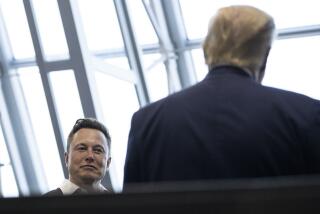Venture Capitalists Stage a Road Show of Their Own
- Share via
MENLO PARK, Calif. — The partners at Kleiner Perkins Caufield & Byers were not happy.
Sure, John Doerr and the firm’s other venture investors were together worth well over $100 million from backing the likes of such onetime technology start-ups as Amazon.com, Netscape Communications and @Home.
And yes, their firm is the cornerstone of Sand Hill Road in Menlo Park, the epicenter of the world’s venture capital billions.
But those jerks down the street at Mohr, Davidow Ventures, which has funded noticeably fewer billion-dollar companies, had just beaten them for the second time in two years in the Sand Hill Challenge, a non-motorized soapbox derby that is ostensibly about charity.
“We’re venture capitalists. We don’t like losing,” said Kleiner partner Ted Schlein.
Kleiner Perkins got its shot at redemption during the third annual event Sunday, along with more than 40 other contestants, as 10,000 onlookers slurped ice cream and sought in vain for a bit of shade.
Organizer Jayne Williams upped the corporate entry fee to $3,000 and raised $200,000 this year for charities that benefit teenagers, including a group that offers teens rides home if they’ve had too much to drink.
The odd thing is that when you include potential labor costs, several of the cars entered by venture capitalists and high-tech law firms sucked up nearly that much money all by themselves.
In fact, the ratio of money spent on cars to funds headed for charity bears a passing resemblance to the ratio of a venture-backed Internet company’s stock price to its yearly earnings.
“The Valley is not about changing the world. It’s about changing the size of your wallet,” said one start-up co-founder and VC beneficiary who came on race day to network. “It’s all right if they want to have a competition, but they shouldn’t bring charity into it.”
At Kleiner Perkins, Schlein turned to an old friend and sometime engineer, Dean Intersimone, to build the firm’s entry this year. “Winning was brought up quite often,” Intersimone said. “I assume there are bets in the back room.”
Despite his day job running start-up Sdreamland.com, a video Web site, Intersimone said the possibility that Kleiner would help fund his company hadn’t come up during his team’s 750 hours of labor on the car.
Kleiner’s entry in the 650-meter race down Sand Hill Road was little more than metal and four wheels pushed from the starting line by three Olympic hopefuls. They were among the handful of world-class athletes recruited by the contestants to provide an extra boost in the first 40 feet.
Kleiner’s archenemy, Mohr Davidow, decided to pull a Michael Jordan and quit while it was ahead.
This year it switched from the speed contest to the “whimsy” category. It stuck with its ally of the last two years, the design firm Ideo. But this time it borrowed from the Hollywood side of the company, the people who created the snake in the film “Anaconda” and the shark in “Deep Blue Sea.”
While the 1997 Mohr Davidow/Ideo car required more than 1,000 hours to perfect and an ex-NFL player to push, the whimsy entry--a red-foam Chinatown dragon on three bouncing motorcycle frames--took a mere 600 hours.
At hourly rates of $100 to $200, that would have approached $100,000 worth of effort.
“You can’t put a value on that time,” said Mike Nuttall, an Ideo co-founder. “It’s what these people love to do.”
Merrill Lynch and other companies tried a different tack this year by sponsoring some of the 16 high school teams that also participated.
Intel, which has more money than God and only slightly less than Bill Gates, led contributions to the event with a $25,000 grant.
And CMGI, a Massachusetts-based Internet conglomerate, had a car designed by Jan Kreig, a defense contractor who worked on both years’ winning Mohr Davidow entries. Kreig said he agreed to do the job when CMGI committed to giving a charity what it spent on building the car--about $15,000.
“I’m as competitive as the next guy, but I just didn’t see the point otherwise,” said Peter Mills, managing partner of CMGI’s Silicon Valley venture capital arm.
The car carried the name of both CMGI and Plugged In, an agency that helps teens start technology businesses.
“It would be nice if the whole thing was run that way,” organizer Williams said.
In the meantime, it was clear that the high school kids have absorbed core lessons about Silicon Valley today--such as the fact that nothing matters more than buzz, which in the Valley can be turned into money and then perhaps, eventually, a product or service.
Jen Creason, the 17-year-old public relations manager for the three entries from Palo Alto High School, seemed proudest about local news coverage of her team. She and other students were also surprised by the intensity and money behind the adult competition.
In exchange for that money, “you get seen on TV and in newspapers,” said Peter Bergstrom, a Woodside High School senior. “It’s good for publicity.”
As for Kleiner Perkins, it lost in the speed category to a car backed by AT&T; Labs and a team of UC Berkeley engineering students, who adapted a super-economy vehicle from an earlier national contest and topped out at a course-record 56 mph.
There’s always next year, of course.
And if Kleiner’s car designer Intersimone needs a second round of financing for his company, he can always cruise a little farther down Sand Hill to the Mohr Davidow office.
The VCs there won the whimsy division, hands down, and are likely to be in a better mood.






